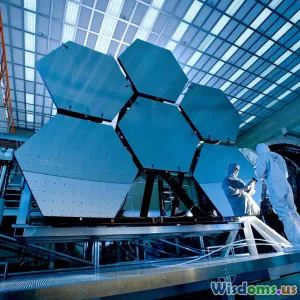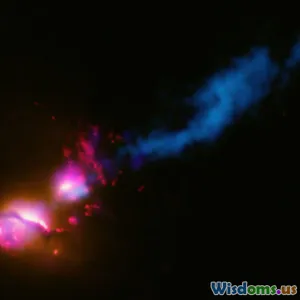
Can Neutron Stars Really Spin Faster Than a Blender
10 min read Explore whether neutron stars truly spin faster than blenders and uncover the extreme astrophysics involved. (0 Reviews)
Can Neutron Stars Really Spin Faster Than a Blender?
If you've ever brewed a smoothie at home, you've probably been amazed by the whirling blades of your blender. These kitchen appliances can reach speeds of up to 30,000 revolutions per minute (RPM), creating a dizzying whirlwind capable of pulverizing even the toughest ingredients. But in the vast, unfathomable cosmos, are there objects that spin even faster?
Enter neutron stars—the remnants of collapsed massive stars, packed so densely that a teaspoon of their material weighs billions of tons. These tiny stellar corpses hold secrets that challenge our understanding of physics and speed. One of their most mind-bending properties: they can spin faster than anything you've seen in your kitchen, possibly outpacing even the fastest blenders. But can they really spin faster? Let's unpack this cosmic mystery.
Understanding Neutron Stars: Nature's Cosmic Whirlers
Neutron stars form when massive stars, those over 8 times the mass of our sun, exhaust their nuclear fuel. Suddenly, gravity takes over, collapsing the star in on itself during a supernova explosion. The core compresses so intensely that electrons and protons merge to form neutrons, creating a compact object roughly 20 kilometers in diameter but packing more mass than our sun.
Despite their diminutive size, neutron stars contain variable properties that make them fascinating—extreme gravity, intense magnetic fields, and rapid rotation.
The Spin Origins
Before collapse, the original star rotates. Due to the conservation of angular momentum, as the star's core contracts drastically in size, its rotational speed must increase to conserve momentum, much like a figure skater pulling in their arms to spin faster. This effect can accelerate the neutron star to phenomenal spin rates.
How Fast Do Neutron Stars Spin?
Neutron stars are renowned for their rapid spins. At the extreme end, the so-called millisecond pulsars can spin hundreds of times per second.
Millisecond Pulsars
Discovered in the 1980s, millisecond pulsars have rotational periods ranging from about 1.4 milliseconds to around 10 milliseconds. This means they can complete between 70 to 700 full rotations every second, translating to rotational speeds from roughly 4,200 to nearly 30,000 RPM or more.
For instance, the fastest known pulsar as of now, PSR J1748-2446ad, spins at an incredible rate of 716 revolutions per second—that's over 43,000 RPM! This speed surpasses almost all human-made machines and certainly beats any household blender.
Comparing to Blenders
Modern kitchen blenders max out around 20,000 to 30,000 RPM at their top settings. Some specialized or industrial blenders may do better, but even then, 43,000 RPM far exceeds typical appliance speeds.
So, when asked if neutron stars spin faster than blenders, the answer technically is yes—certain neutron stars can out-spin them significantly.
Physical Limits to Spin
Physicists wonder: how fast can a neutron star spin before it breaks apart? This speed limit depends on the star's mass, size, and internal structure. When an object spins too fast, centrifugal forces can tear it apart or cause it to deform. For neutron stars, the theoretical maximum spin frequency is believed to be near 1,122 rotations per second (~67,000 RPM), though no star has yet been observed spinning this fast.
Measuring These Extreme Rotations
Detecting these cosmic whirlers isn't as straightforward as watching kitchen gadgets spin. Since neutron stars are small and distant (often many thousands of light-years away), astronomers rely on indirect methods.
Pulsar Signals
Many neutron stars are observed as pulsars, which emit beams of electromagnetic radiation—like cosmic lighthouses. As these beams sweep across Earth, telescopes pick up regular pulses of radio waves or X-rays. By analyzing the periodicity of these pulses, scientists determine the star's spin rate with astonishing precision.
Insights from Radio and X-ray Telescopes
High-powered instruments like the Arecibo Observatory (before its collapse), the FAST radio telescope in China, and NASA's NICER instrument aboard the International Space Station have refined pulsar measurements. These tools can probe a millisecond-scale spin with microsecond timing, confirming the record-breaking spin rates of neutron stars.
Why Do Neutron Stars Spin So Fast?
Conservation of Angular Momentum
The key to rapid spin rates is shrinking radius. If a star shrinks dramatically without losing angular momentum, it spins faster. Neutron stars can be hundreds of thousands of times smaller than their progenitor stars, leading to massive spin acceleration.
Accretion Spin-Up
Some neutron stars are part of binary systems, feeding off a companion star’s material. As this matter spirals inward, it transfers angular momentum to the neutron star, spinning it up further in a process called accretion-induced spin-up. This mechanism explains the existence of millisecond pulsars.
Broader Implications of Neutron Star Spin
Testing Physics Under Extreme Conditions
Neutron stars serve as cosmic laboratories for physics beyond Earthly capabilities. Their rapid spins, ultra-high densities, and magnetic fields test theories about matter under intense gravity and nuclear forces.
For example, the maximum spin rate gives clues about the equation of state—the relationship between density and pressure inside neutron stars—one of astrophysics' biggest open questions.
Gravitational Waves and Spin
Fast-spinning neutron stars with slight asymmetries can emit gravitational waves, ripples in spacetime first directly observed in 2015. These waves are sensitive to rotation and structural details, making pulsars key targets in gravitational wave astronomy.
Can Neutron Stars Outspin Everything?
While neutron stars outpace everyday objects like blenders, the cosmos hosts objects with even more extreme rotational energies.
Black Holes and Accretion Disks
Black holes don’t have a solid surface to spin, but their event horizons can exhibit extreme rotation rates. Moreover, accretion disks around black holes rotate fast, sometimes reaching relativistic speeds near the speed of light.
Subatomic Particles
On the microscopic scale, particles like quarks and electrons possess intrinsic angular momentum called spin, but this is quantum mechanical and not directly comparable to classical rotation.
Conclusion: The Cosmic Speed Champions
The simple comparison of a blender and a neutron star spinning might seem whimsical, but neutron stars genuinely blow blenders—and nearly all terrestrial machines—out of the water when it comes to spin rate.
- Neutron stars, particularly millisecond pulsars, spin at staggering speeds up to over 40,000 RPM, exceeding typical blender speeds.
- Their rapid rotation arises from their collapse and accretion processes, guided by fundamental physics like conservation of angular momentum.
- Observing these stars challenges our technology and expands understanding of matter and energy in the universe.
While we might admire the swift swirl in our kitchen blenders, next time you watch it operate, remember that somewhere far across the galaxy, a neutron star might be spinning hundreds or thousands of times faster—a testament to the mesmerizing extremes of our universe.
References:
- Hessels, J. W. T., et al. "A Radio Pulsar Spinning at 716 Hz." Science, 2006.
- Riles, Keith. "Recent Searches for Continuous Gravitational Waves." Modern Physics Letters A, 2013.
- Lattimer, James M., and M. Prakash. "The Equation of State of Hot, Dense Matter and Neutron Stars." Science, 2004.
- Lorimer, Duncan. Handbook of Pulsar Astronomy, Cambridge University Press, 2004.
Did you enjoy this cosmic spin comparison? Feel free to explore more wonders of astrophysics and the universe’s most incredible phenomena.
Rate the Post
User Reviews
Popular Posts

















